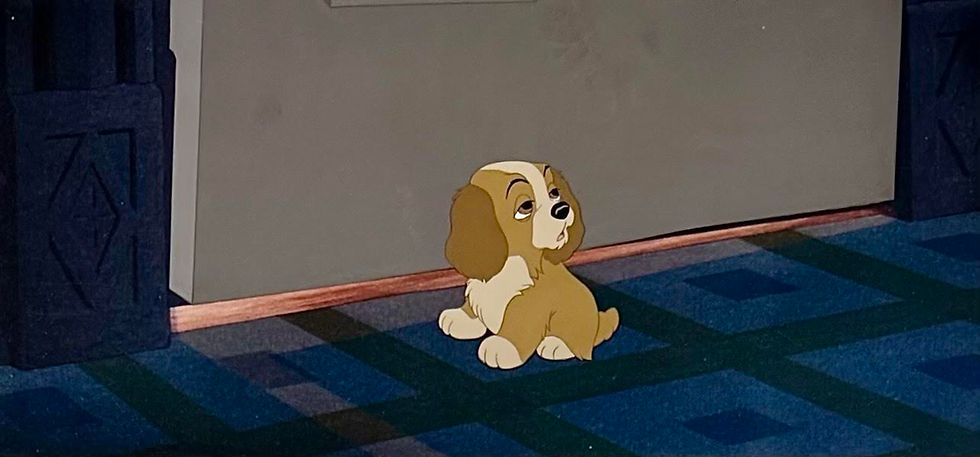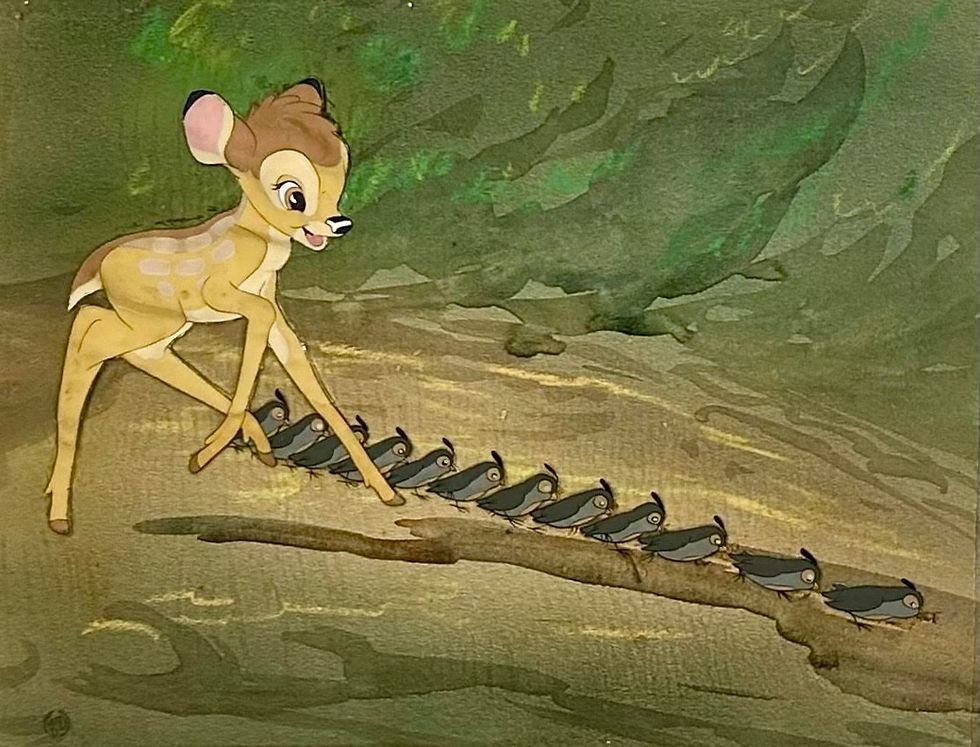Original Production Animation Drawing of Mickey Mouse from "The Sorcerer's Apprentice" sequence of "Fantasia," 1940
- Untitled Art Gallery

- Jan 25, 2024
- 4 min read

Original production animation drawing of Mickey Mouse in red and graphite pencils; Numbered 110 1/2 lower and upper right, and used during the production of "The Sorcerer's Apprentice" sequence of "Fantasia," 1940, Walt Disney Studios; Size - Mickey Mouse: 7 x 7 1/4", Sheet 10 x 12"; Unframed.
"Fantasia" is the third full length animated feature film produced by Walt Disney and released by Walt Disney Productions on November 13, 1940. Story direction was by Joe Grant and Dick Huemer and production supervision was by Ben Sharpsteen. The film consists of eight animated segments, each set to a piece of classical music conducted by Leopold Stokowski. Seven of pieces were performed by the Philadelphia Orchestra, and "The Sorcerer's Apprentice" used an ad hoc studio orchestra. A live action introduction to each animated segment was by the Master of Ceremonies, music critic and composer Deems Taylor.
The concept of the film was developed as Disney was near the completion of a Silly Symphony, "The Sorcerer's Apprentice;" which was designed to be a comeback role for Mickey Mouse, who had declined in popularity. The production costs for the short had grown higher than it would have been able to earn as a stand alone short, so Disney decided to include it within a full length feature film, along with other classic music created animated shorts.
The soundtrack for "Fantasia" was recorded using multiple audio channels and reproduced with "Fantasound," a pioneering sound reproduction system that made "Fantasia" the first commercial film shown with stereophonic sound. The film was released as a theatrical roadshow in thirteen US cities, and although acclaimed by critics; it was unable to make a profit due to World War II cutting off distribution to the European market, the initial high production costs, and the expense of leasing theaters and installing the "Fantasound" equipment. The film was subsequently reissued multiple times with it's original footage and audio being deleted, modified, and/or restored in each version. "Fantasia" is now the 23rd highest-grossing film of all time in the US, when adjusted for inflation. In 1998 the American Film Institute ranked it as the 58th greatest American film in their "100 Years... 100 Movies" and the fifth greatest animated film in their "10 Top 10" list. In 1990, "Fantasia" was selected for preservation in the United States National Film Registry by the Library of Congress as being, "culturally, historically, or aesthetically significant." A sequel, "Fantasia 2000" was co-produced by Roy E. Disney and was released in 1999.
Over 1,000 artists and technicians were used in the making of "Fantasia," resulting in more than 500 animated characters. "The Nutcracker Suite," originally composted by Pyotr Ilyich Tchaikovsky, is made up of selections from the ballet suite underscoring scenes depicting the changing seasons from summer to winter. A variety of dancers are utilized including fairies, fish, flowers, mushrooms, and leaves; and including the music scores of "Dance of the Sugar Plum Fairy," "Chinese Dance," "Arabian Dance," Russian Dance," "Dance of the Flutes," and "Waltz of the Flowers."
"The Sorcerer's Apprentice" was initially going to be a "Silly Symphonies" short and be a venue for a comeback role for Mickey Mouse, who had declined in popularity. However, it was eventually included in the full length feature film "Fantasia," in 1940. The Disney version of "The Sorcerer's Apprentice" is based on the 1797 poem by Goethe of the same name. Mickey Mouse takes the role of the apprentice and the only real change from the original poem occurs when the Sorcerer is stern and angry with the apprentice after he saves him from a spell gone horribly wrong.
In 1935 a young animator, born in Los Angeles, named Fred Moore gave Mickey his first makeover. Earlier animators had drawn the mouse as a series of circles, which limited his movement. Moore gave him a pear-shaped body, pupils, white gloves, and a shortened nose; all of which added to make the World's most famous mouse a lot cuter. Moore animated Mickey Mouse for the 1938 short "The Brave Little Tailor," which was to be the last significant appearance of the "pie-eyed" Mickey. For "Fantasia," 1940 the "pie-eyes" were gone and Moore's complete transformation of Mickey Mouse for the film continues to be his official look up to this day.
"The Sorcerer's Apprentice," is perhaps Mickey Mouse's most well known role (despite the fact that he never utters a single word), and as such it was the only 1940 segment that was added to the later film "Fantasia, 2000." "The Sorcerer's Apprentice" starts with Sorcerer Yen Sid (Disney spelled backwards) who is working on his magic while his apprentice Mickey Mouse is doing chores. After some magic, Yen Sid puts his hat down, yawns, and leaves the room to retire to his chambers. When he is out of sight, Mickey puts the Sorcerer's hat on and tries to magically animate a broom. He commands the broom to carry buckets of water to fill a cauldron. Since Mickey is satisfied, he sits down on the chair and falls asleep. He dreams that he is a powerful sorcerer high on top of a mountain pinnacle commanding the stars, planets, and water. Mickey is suddenly woken up by being splashed by water and finding the room is filled with water, and despite the cauldron is overflowing, the broom carrying the bucket of water is not stopping.
Original production drawings of Mickey Mouse from "Fantasia" are extremely rare and highly collected. This is a full figure image of Mickey, wearing his robe, Sorcerer's magic hat, and large brown shoes. His left arm is extended above him as he dreams of commanding stars, planets, and large waves of water below him. A large, centered, and action packed production drawing of Mickey Mouse accomplished in red and graphite pencils would make a great addition to any vintage Walt Disney animation art collection!






